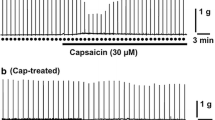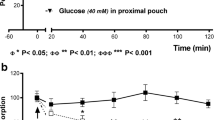The effects of densensitization of capsaicin-sensitive afferent neurons on the microcirculation in the stomach were studied before and after administration of indomethacin at an ulcerogenic dose in adrenalectomized rats receiving and not receiving replacement therapy with corticosterone and in sham-operated animals. Measures of the microcirculation consisted of blood flow rates in microvessels in the submucous layer of the stomach and the diameter and permeability of microvessels in the mucosa. Desensitization of capsaicin-sensitive afferent neurons was performed by administration of capsaicin at a dose of 100 mg/kg for two weeks and adrenalectomy one week before the experiment. Blood flow rates in microvessels and microvessel diameters were assessed in non-anesthetized rats by direct video recording methods using a special optical system with a contact dark-field epiobjective. Administration of indomethacin at an ulcerogenic dose led to decreases in blood flow rate in microvessels in the submucous layer, dilation of superficial microvessels in the mucosa of the stomach, and an increase in their permeability. Desensitization of capsaicin-sensitive neurons potentiated indomethacin-induced impairments to the microcirculation in the submucous layer and the mucosa of the stomach. These effects of densensitization were significantly enhanced in conditions of glucocorticoid hormone deficiency. Thus, glucocorticoid hormones have favorable effects on the gastric microcirculation in rats with desensitization of capsaicin-sensitive afferent neurons.
Similar content being viewed by others
References
P. Yu. Bobryshev, T. T. Podvigina, T. R. Bagaeva, and L. P. Filaretova, “Compensatory gastroprotective actions of glucocorticoid hormones in conditions of exclusion of the functioning of capsaicinsensitive neuron afferents in rats,” Ros. Fiziol. Zh. im. I. M. Sechenova, 92, No. 8, 1006–1015 (2006).
P. Yu. Bobryshev, T. T. Podvigina, N. A. Mal’tsev, Yu. I. Levkovich, and L. P. Filaretov, “Effects of desensitization of capsaicin-sensitive neurons on the blood flow rate in microvessels of the serous-muscular layer of the stomach in rats with normal and deficient contents of glucocorticoid hormones,” Ros. Fiziol. Zh. im. I. M. Sechenova, 92, No. 12, 1483–1492 (2006).
L. P. Filaretov, Yu. I. Levkovich, and N. A. Mal’tsev, “Corticosteroids limit reductions in the blood flow rate in microvessels of the submucous layer of the stomach in stress in rats,” Ros. Fiziol. Zh. im. I. M. Sechenova, 82, No. 1, 71–78 (1996).
L. P. Filaretov, T. T. Podvigina, T. R. Bagaeva, and P. Yu. Bobryshev, “The gastroprotective role of glucocorticoid hormones, Ros. Fiziol. Zh. im. I. M. Sechenova, 93, No. 11, 1217–1228 (2007).
O. M. E. Abdel-Salam, J. Czimmer, A. Debreceni, J. Szolcsanyi, and G. Mozsik, “Gastric mucosal integrity: gastric mucosal blood flow and microcirculation. An overview,” J. Physiol. Paris, 95, No. 1–6, 105–127 (2001).
P. Bobryshev, T. R. Bagaeva, and L. P. Filaretova, “Gastroprotective action of glucocorticoid hormones in rats with desensitization of capsaicin-sensitive sensory neurons,” Inflammopharmacology, 13, No. 1–3, 217–228 (2005).
L. P. Filaretova, “The hypothalamic-pituitary-adrenocortical system: hormonal brain-gut interaction and gastroprotection,” Auton. Neurosci., 125, No. 1–2, 86–93 (2006).
L. P. Filaretova, T. R. Bagaeva, and G. B. Makara, “Aggravation of nonsteroidal antiinflammatory drug gastropathy by glucocorticoid deficiency or blockade of glucocorticoid receptor in rats,” Life Sci., 71, No. 21, 2457–2468 (2002).
L. P. Filaretova, A. M. Maltcev, A. I. Bogdanov, and Yu. I. Levkovich, “Role of gastric micro-circulation in the gastroprotection by glucocorticoids released during water-restraint stress in rats,” Chin. J. Physiol., 42, No. 3, 145–152 (1999).
L. P. Filaretova, T. T. Podvigina, T. R. Bagaeva, A. Tanaka, and K. Takeuchi, “Mechanisms underlying gastroprotective action of glucocorticoids released in response to ulcerogenic stress factors,” Ann. N.Y. Acad. Sci., 1018, No. 1–5, 288–293 (2004).
L. Filaretova, A. Tanaka, S. Kato, T. Miyazawa, and K. Takeuchi, “Mechanisms underlying protective action of endogenous glucocorticoids against indomethacin-induced gastric injury in rats,” Amer. J. Physiol., 283, No. 5, G1082–G1089 (2002).
P. Holzer, “Neural emergency system in the stomach,” Gastroenterology, 114, No. 4, 823–839 (1998).
P. Holzer, “Efferent-like roles of afferent neurons in the gut: Blood flow regulation and tissue protection,” Auton. Neurosci., 125, No. 1–2, 70–75 (2006).
P. Holzer, E. H. Livingston, and P. H. Guth, “Sensory neurons signal for an increase in rat gastric mucosal blood flow in the face of pending acid injury,” Gastroenterology, 101, No. 2, 416–423 (1991).
S. Katayama, H. Shionoya, and S. Ohtake, “A new method for extraction of extravasated dye in the skin and the influence of fasting stress on passive cutaneous anaphylaxis in guinea pigs and rats,” Microbiol. Immunol., 22, No. 2, 89–101 (1978).
K. Svanes, J. E. Varhaug, H. Dzienis, and J. E. Groonbech, “Gastric mucosal blood flow related to acute mucosal damage,” Scand. J. Gastroenterol., 19, Supplement 105, 62–64 (1984).
K. Takeuchi, M. Okada, S. Ebara, and H. Osano, “Increased microvascular permeability and lesion formation during gastric hypermotility caused by indomethacin and 2-deoxy-D-glucose in the rat,” J. Clin. Gastroenterol., 12, No. 1, S76–S84 (1990).
K. Takeuchi, S. Kato, M. Takeeda, Y. Ogawa, M. Nakashima, and M. Matsumoto, “Facilitation by endogenous prostaglandins of capsaicin-induced protection in rodent through EP2 and IP receptors,” Gastroenterology, 97, No. 2, 284–293 (1989).
B. J. R. Whittle, J. Lopez-Belmonte, and S. Moncada, “Regulation of gastric mucosal integrity by endogenous nitric oxide: interactions with prostanoids and sensory neuropeptides in the rats,” Brit. J. Pharmacol., 99, No. 3, 606–611 (1990).
Author information
Authors and Affiliations
Corresponding author
Additional information
Translated from Rossiiskii Fiziologicheskii Zhurnal imeni I. M. Sechenova, Vol. 94, No. 6, pp. 700–709, June, 2008.
Rights and permissions
About this article
Cite this article
Podvigina, T.T., Bobryshev, P.Y., Bagaeva, T.R. et al. The effects of desensitization of capsaicin-sensitive afferent neurons on the microcirculation in the stomach in rats depend on the blood glucocorticoid hormone level. Neurosci Behav Physi 39, 559–564 (2009). https://doi.org/10.1007/s11055-009-9172-0
Received:
Published:
Issue Date:
DOI: https://doi.org/10.1007/s11055-009-9172-0




